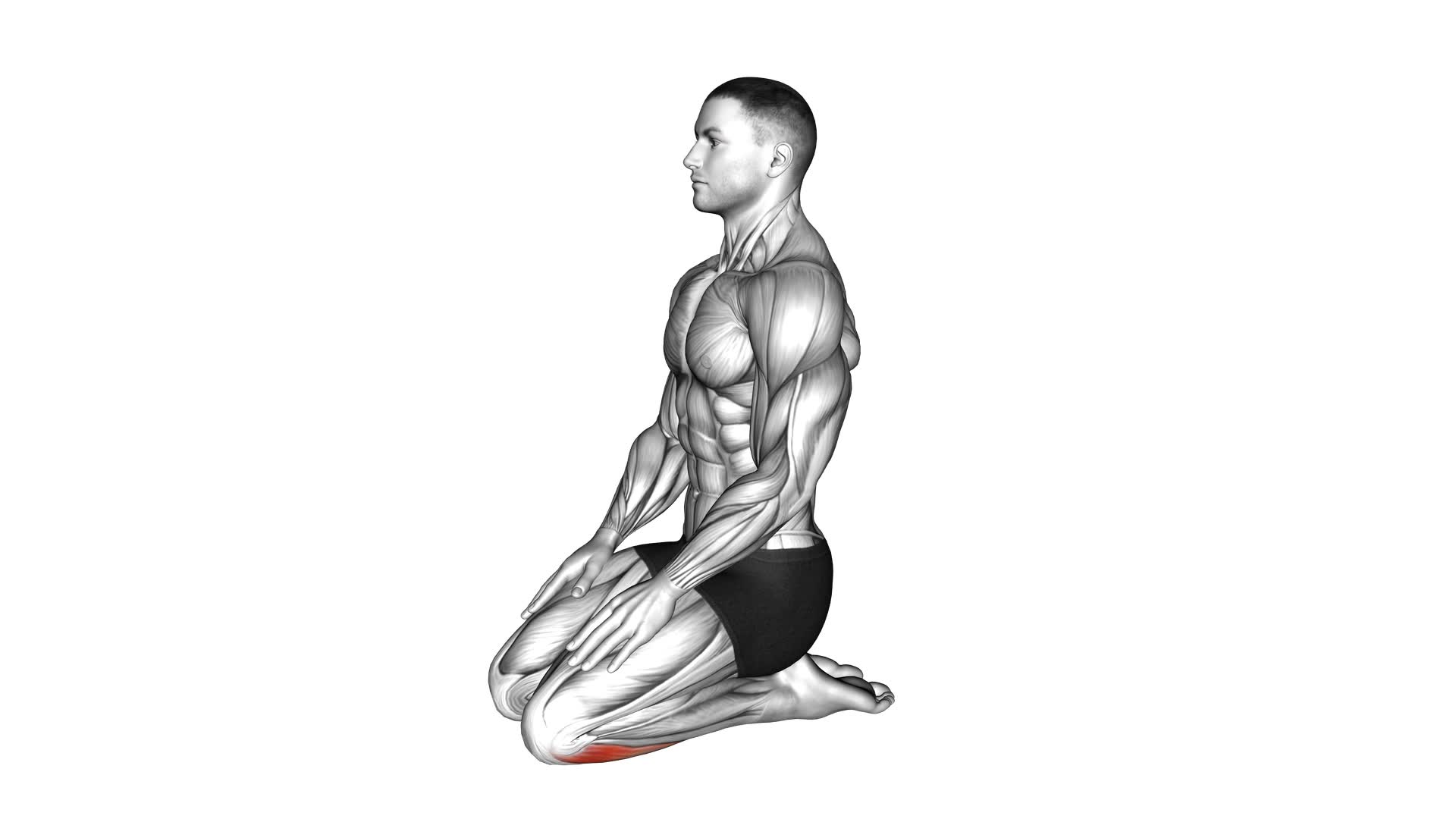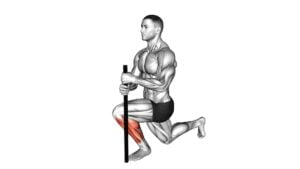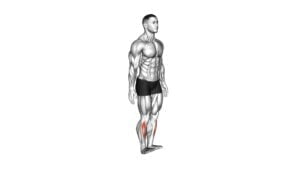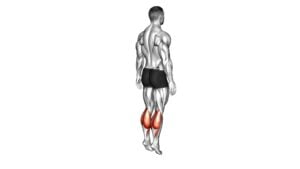Seated Ankle Stretch – Video Exercise Guide & Tips

Are you looking to improve ankle flexibility and relieve tightness? Look no further than the Seated Ankle Stretch!
Watch This Exercise Video
In this video exercise guide, you'll learn the proper technique, common mistakes to avoid, and tips for progressing the stretch.
Whether you're a beginner or advanced, modifications are available for different fitness levels. However, remember to take precautions and consider your individual needs before attempting this stretch.
Get ready to enhance your ankle mobility with this effective exercise!
Key Takeaways
- The seated ankle stretch improves ankle flexibility and range of motion.
- It enhances athletic performance by increasing agility and balance.
- The stretch helps prevent injuries, particularly in high-impact sports.
- It targets the ankle joint and surrounding muscles for better joint mobility.
Benefits of the Seated Ankle Stretch
By performing the seated ankle stretch, you can improve flexibility and increase the range of motion in your ankles. This stretch is beneficial for athletes as it helps in enhancing athletic performance. When you have increased flexibility in your ankles, you can move more freely and with greater ease, allowing for better agility and balance. This is especially important in sports that require quick changes in direction or jumping movements.
Improving flexibility in your ankles can also help prevent injuries. When your ankles are more flexible, they're less likely to become strained or twisted during physical activity. This can be particularly useful in high-impact sports like basketball, soccer, or running, where the ankles are constantly under stress.
The seated ankle stretch specifically targets the ankle joint and the surrounding muscles, including the calves and shins. By stretching these muscles, you can reduce muscle tightness and improve overall joint mobility. This can translate to better performance in activities that involve ankle movement, such as squatting, lunging, or jumping.
Incorporating the seated ankle stretch into your regular exercise routine can have long-term benefits for your athletic performance. It's a simple yet effective stretch that can be done anywhere, making it a convenient addition to your warm-up or cool-down routine.
Proper Technique for the Seated Ankle Stretch
To properly perform the seated ankle stretch, follow these steps to ensure maximum effectiveness and avoid any potential injuries.
- Start by sitting on the ground with your legs extended in front of you.
- Bend one knee and place the sole of your foot on the ground, close to your opposite knee.
- Keep your back straight and engage your core muscles for stability.
- Next, gently grasp your toes or the top of your foot with your hand, and slowly pull your foot towards your body.
- You should feel a stretch in your ankle and the back of your calf.
- Hold this position for 20-30 seconds, while breathing deeply and relaxing into the stretch.
- Repeat on the other side.
It's important to note that the seated ankle stretch can be modified for individuals with limited flexibility.
- If you're unable to reach your toes or foot, you can use a towel or a resistance band to assist you.
- Simply loop the towel or band around your foot and hold onto the ends, then pull gently towards your body.
As with any exercise, there are some precautions to keep in mind when performing the seated ankle stretch.
- Make sure to listen to your body and avoid any sharp or intense pain.
- If you have any existing injuries or conditions, such as ankle sprains or chronic pain, it's best to consult with a healthcare professional before attempting this stretch.
- Additionally, it's important to warm up your muscles before stretching to prevent injury.
- Incorporating the seated ankle stretch into your regular stretching routine can help improve ankle flexibility and prevent stiffness.
Common Mistakes to Avoid
To avoid common mistakes when performing the seated ankle stretch, be mindful of your technique and pay attention to the following guidelines:
- Avoid bouncing: Bouncing or jerking movements can lead to injuries and strain on the ankle joint. Instead, perform slow and controlled movements to maximize effectiveness and minimize the risk of injury.
- Don't force the stretch: It's important to listen to your body and not push beyond your limits. If you feel pain or discomfort, ease off the stretch and adjust accordingly. Pushing too hard can result in injuries and hinder your progress.
- Maintain proper posture: Keep your back straight and shoulders relaxed throughout the stretch. Slouching or hunching over can affect the alignment of your spine and decrease the effectiveness of the stretch.
- Engage the correct muscles: Focus on contracting the muscles in your calves and ankles during the stretch. This will help to maximize the effectiveness of the exercise and target the intended muscle groups.
By following these guidelines, you can avoid injuries and maximize the effectiveness of the seated ankle stretch. Remember to always listen to your body and make adjustments as needed.
Happy stretching!
Tips for Progressing the Seated Ankle Stretch
How can you continue to challenge yourself and make progress with the seated ankle stretch? Here are some progression tips and stretching modifications to help you take your seated ankle stretch to the next level.
- Increase the duration: Start by holding the stretch for 30 seconds and gradually increase the duration to 60 seconds or more. This will help improve flexibility and range of motion in your ankles.
- Use resistance: Place a resistance band around the ball of your foot and hold onto the ends with your hands. Gently pull the band towards you while maintaining the stretch. This will add resistance and intensify the stretch.
- Add ankle weights: Ankle weights can be a great way to challenge your ankle muscles and increase the difficulty of the stretch. Start with light weights and gradually increase the load as you get stronger.
- Incorporate dynamic movements: Once you have mastered the seated ankle stretch, you can add dynamic movements to further challenge your ankle stability and flexibility. Try gently moving your ankle in circles or side to side while maintaining the stretch.
Remember to listen to your body and only progress at a pace that feels comfortable for you. If you experience any pain or discomfort, stop immediately and consult with a healthcare professional.
Modifications for Different Fitness Levels
As you progress with the seated ankle stretch, there are modifications available to accommodate different fitness levels. Whether you're a beginner just starting out or an advanced practitioner looking for a more challenging variation, these modifications will help you tailor the exercise to your specific needs and abilities.
Here are four modifications for different fitness levels:
- Beginner's Modification: If you're new to the seated ankle stretch, you can start by sitting on a folded blanket or yoga block to elevate your hips. This will reduce the intensity of the stretch and make it more accessible for beginners.
- Intermediate Modification: Once you feel comfortable with the basic seated ankle stretch, you can progress by extending your legs straight out in front of you. This will increase the stretch and engage your core muscles for added stability.
- Advanced Modification: For those who are looking for a more challenging variation, you can try adding resistance by using a resistance band or ankle weights. This will increase the intensity of the stretch and provide a greater challenge for your muscles.
- Modifications for Flexibility: If you have limited flexibility in your ankles, you can modify the stretch by using a towel or yoga strap to gently pull your foot towards you. This will help improve your ankle mobility over time.
Remember to listen to your body and only progress to more advanced modifications when you feel ready. By incorporating these modifications into your seated ankle stretch routine, you can customize the exercise to your fitness level and continue to challenge yourself as you improve.
Precautions and Considerations for the Seated Ankle Stretch
Before starting the seated ankle stretch, it's important to take certain precautions to prevent injuries.
Make sure to warm up your ankles before performing the stretch to increase flexibility and reduce the risk of strains.
Additionally, consider variations in the stretching technique to cater to your specific needs and abilities.
Injury Prevention Tips
To prevent injuries while performing the seated ankle stretch, follow these three key tips:
- Start slowly: Begin with gentle ankle mobility exercises to warm up the muscles and prepare them for stretching. This will help reduce the risk of strains or sprains.
- Maintain proper form: Ensure that your back remains straight, and your shoulders are relaxed throughout the stretch. Avoid any excessive force or bouncing movements that could lead to injury.
- Listen to your body: Pay attention to any discomfort or pain during the stretch. If you feel any sharp or intense pain, stop immediately and consult a healthcare professional.
- Gradually increase intensity: As you become more comfortable with the seated ankle stretch, you can gradually increase the intensity and duration of the exercise. This will help improve ankle flexibility over time.
Stretching Technique Variations
Take caution when modifying the seated ankle stretch technique to ensure proper form and prevent injury.
While there are various stretching modifications and advanced variations available for the seated ankle stretch, it's important to approach them with care and gradually progress to more challenging variations.
When attempting advanced variations, such as using resistance bands or adding weights, it's crucial to maintain control and avoid overstretching the ankle joint.
Always listen to your body and stop if you feel any pain or discomfort.
Additionally, consult with a qualified fitness professional or physical therapist for guidance on proper technique and progression.
Frequently Asked Questions
Can the Seated Ankle Stretch Help With Ankle Injuries or Rehabilitation?
The seated ankle stretch is a beneficial exercise for ankle injury prevention and rehabilitation. By engaging the muscles and tissues around the ankle joint, this stretch helps to strengthen and increase flexibility, reducing the risk of future injuries.
It's important to perform this exercise correctly and gradually increase the intensity to avoid further injury. Incorporating ankle strengthening exercises, like the seated ankle stretch, into your routine can greatly improve ankle stability and overall function.
Is It Necessary to Warm up Before Performing the Seated Ankle Stretch?
Before performing the seated ankle stretch, it's important to warm up your body. Warming up has several benefits, such as increasing blood flow to your muscles, improving flexibility, and reducing the risk of injury.
While the seated ankle stretch itself may not be strenuous, a warm-up prepares your body for the exercise. If you're short on time or unable to perform a traditional warm-up, there are alternative warm-up exercises that can help prepare your ankles for the stretch.
How Long Should I Hold the Stretch for Maximum Benefit?
For maximum benefit, the optimal duration to hold the seated ankle stretch is typically around 30 seconds to 1 minute. This allows your muscles and connective tissues to fully elongate and improve flexibility.
However, it's important to listen to your body and not push beyond your comfort level or cause pain. Remember to use proper stretching techniques, such as maintaining good posture and breathing deeply throughout the stretch.
Can the Seated Ankle Stretch Improve Flexibility in Other Parts of the Body?
Improving overall flexibility is essential for increasing range of motion in various parts of your body. One effective exercise that can contribute to this is the seated ankle stretch. By targeting the ankle joints and muscles, this stretch can have a positive impact on your overall flexibility.
As you work on increasing the range of motion in your ankles, you may also notice improvements in other areas, such as your calves and lower legs.
Are There Any Alternative Stretches or Exercises That Can Complement the Seated Ankle Stretch?
If you're looking for alternative exercises to complement the seated ankle stretch, there are a few options you can consider.
Incorporating calf stretches, such as the standing calf stretch or the downward dog pose in yoga, can help improve flexibility in the lower body.
Additionally, incorporating hip stretches like the seated forward bend or the pigeon pose can help stretch the muscles surrounding the ankles and improve overall flexibility.
Including these exercises in your stretching routine can provide a well-rounded approach to improving ankle flexibility.
Conclusion
In conclusion, the seated ankle stretch is a beneficial exercise for improving ankle flexibility and mobility. By following the proper technique and avoiding common mistakes, individuals can safely and effectively stretch their ankles.
Additionally, tips for progressing the stretch and modifications for different fitness levels allow for continued growth and improvement.
It's important to always consider precautions and individual considerations when performing the seated ankle stretch to ensure a safe and effective workout.

Author
Years ago, the spark of my life’s passion ignited in my mind the moment I stepped into the local gym for the first time. The inaugural bead of perspiration, the initial endeavor, the very first surge of endorphins, and a sense of pride that washed over me post-workout marked the beginning of my deep-seated interest in strength sports, fitness, and sports nutrition. This very curiosity blossomed rapidly into a profound fascination, propelling me to earn a Master’s degree in Physical Education from the Academy of Physical Education in Krakow, followed by a Sports Manager diploma from the Jagiellonian University. My journey of growth led me to gain more specialized qualifications, such as being a certified personal trainer with a focus on sports dietetics, a lifeguard, and an instructor for wellness and corrective gymnastics. Theoretical knowledge paired seamlessly with practical experience, reinforcing my belief that the transformation of individuals under my guidance was also a reflection of my personal growth. This belief holds true even today. Each day, I strive to push the boundaries and explore new realms. These realms gently elevate me to greater heights. The unique combination of passion for my field and the continuous quest for growth fuels my drive to break new ground.



